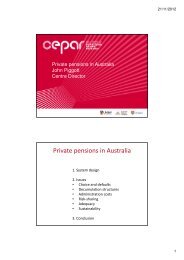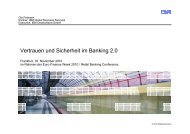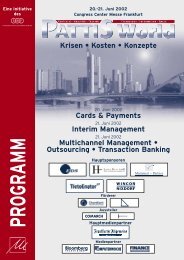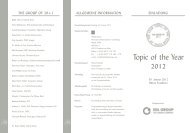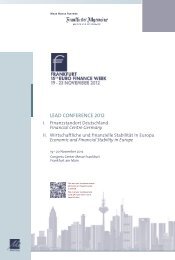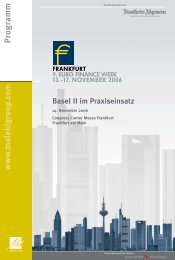BASF pension funds
BASF pension funds
BASF pension funds
Create successful ePaper yourself
Turn your PDF publications into a flip-book with our unique Google optimized e-Paper software.
European Pension Funds<br />
Congress 2010<br />
EC Green Paper on the Future of Pensions in the EU<br />
Dr. Withold Galinat, <strong>BASF</strong> SE<br />
November 16, 2010<br />
Human Resources<br />
1
Human Resources<br />
About <strong>BASF</strong><br />
<strong>BASF</strong> – The Chemical Company<br />
� The world's leading chemical<br />
company<br />
� Sales 2009: 50.693 billion €<br />
� Region Europe 28.5 billion €<br />
� Offers intelligent system solution<br />
und premium products for almost<br />
all markets<br />
� Earnings (EBIT) 2009:<br />
3.677 billion €<br />
� Employees (31.12.2009): 104,779<br />
� Employees Region Europe: 67,621<br />
2
Human Resources<br />
<strong>BASF</strong> Pensionskasse<br />
� <strong>BASF</strong> started providing occupational <strong>pension</strong> benefits in 1871<br />
� <strong>BASF</strong> Pensionskasse was founded in 1888<br />
� <strong>BASF</strong> Pensionskasse in 2009:<br />
� more than 62,000 active members<br />
� ca. 5.5 billion € <strong>pension</strong> liabilities<br />
� ca. 40,000 retirees<br />
� ca. 190 million € <strong>pension</strong> payments p.a.<br />
� Worldwide:<br />
� EU:<br />
� ca. 15 billion € <strong>pension</strong> liabilities<br />
� ca. 767 million € <strong>pension</strong> payments p.a.<br />
� ca. 10 billion € <strong>pension</strong> liabilities<br />
� ca. 499 million € <strong>pension</strong> payments p.a.<br />
3
Human Resources<br />
Employee Appreciation<br />
of <strong>BASF</strong> SE Pension Scheme<br />
How do you evaluate your<br />
personal benefit gained from the<br />
occupational <strong>pension</strong> scheme<br />
provided by <strong>BASF</strong> SE?<br />
2009<br />
48 41 10<br />
very high high average low very low<br />
2008<br />
47 42 9<br />
very high high average low very low<br />
2007<br />
48 41 10<br />
very high high average low very low<br />
4
Human Resources<br />
<strong>BASF</strong> <strong>pension</strong> <strong>funds</strong> (IORPs) in Europe<br />
� Austria (multi employer fund)<br />
� Belgium<br />
� Germany<br />
� Ireland<br />
� Netherlands<br />
� Spain<br />
� Switzerland<br />
� U.K.<br />
5
Human Resources<br />
Questions of the Green Paper on Pensions<br />
Removing obstacles to mobility<br />
5. In which way should the IORP Directive be amended to improve the conditions<br />
for cross-border activity?<br />
<strong>BASF</strong>’s assessment and view<br />
� It may be too early to amend the IORP directive<br />
� Allow employers and supervisory authorities more time for obtaining<br />
experience<br />
� Rather than amending the IORP directive the EU should ensure its<br />
consistent application<br />
� “Fully funded at all times“ (Art.16, 3)<br />
� Establishing a separate, 28 th EU <strong>pension</strong> regime in addition to those of the<br />
Member States does not appear useful as it will add additional complexity<br />
rather than provide the desired simplification<br />
6
Human Resources<br />
Questions of the Green Paper on Pensions<br />
Removing obstacles to mobility<br />
6. What should be the scope of schemes covered by EU level action on portability?<br />
7. Should the EU look again at the issue of transfers or would minimum standards<br />
on acquisition and preservation plus an EU level tracking service for all types of<br />
<strong>pension</strong> rights be a better solution?<br />
<strong>BASF</strong>’s assessment and view<br />
� Occupational <strong>pension</strong>s are only a minor issue in the context of cross-border mobility within a<br />
globally-operating company. Therefore, this topic does neither need nor justify extensive EU<br />
regulation.<br />
� If the portability will be revisited, the EU should focus on transferability of <strong>pension</strong>s, whereby<br />
such transferability should be based on a capital transfer with the releasing scheme<br />
determining the transfer amount on the basis of its rules and the receiving determining the<br />
amount of <strong>pension</strong> purchased with the transfer amount in accordance with its rules. Smaller<br />
and medium-sized schemes should be protected against large outflows of capital.<br />
� The EU should not look again at acquisition and preservation of <strong>pension</strong> rights, i.e. increasing<br />
minimum standards on vesting and indexation of vested entitlements.<br />
� The EU may consider a tracking service for all types of <strong>pension</strong> rights, but this service should<br />
be set up by the member states with mandatory coordination cross-border such as with state<br />
<strong>pension</strong>s.<br />
7
Human Resources<br />
Questions of the Green Paper on Pensions<br />
Safer, more transparent <strong>pension</strong>s, better<br />
awareness and information<br />
8. Which elements of the current EU legislation should be reviewed to ensure a<br />
consistent regulation and supervision of funded <strong>pension</strong> schemes and products?<br />
9. How could European regulation or a code of good practice help Member States<br />
achieve a better balance for <strong>pension</strong> savers and <strong>pension</strong> providers between risks,<br />
security and affordability?<br />
<strong>BASF</strong>’s assessment and view<br />
� It would be helpful, if the somewhat fuzzy and unclear boundaries between<br />
social security schemes and private schemes, occupational and individual<br />
schemes, voluntary and mandatory schemes could be made clearer<br />
through a uniform, concise <strong>pension</strong>s terminology.<br />
� The EU could help the Member States to achieve an appropriate balance<br />
between risks, security and affordability by extending the open method of<br />
coordination to occupational <strong>pension</strong>s, whereby best practice solutions<br />
would be presented and discussed.<br />
8
Human Resources<br />
Questions of the Green Paper on Pensions<br />
Safer, more transparent <strong>pension</strong>s, better<br />
awareness and information<br />
10. What should an equivalent solvency regime for <strong>pension</strong>s <strong>funds</strong> look like?<br />
<strong>BASF</strong>’s assessment and view<br />
� Pension <strong>funds</strong> are social institutions which are different from insurance undertakings, hence<br />
the Solvency II regime is not an adequate standard for them<br />
� No third party interest as employers and employee representatives<br />
� All surplus returns are distributed among scheme members<br />
� Significantly higher duration of liabilities<br />
� Vesting of entitlements rather than midterm cancellations<br />
� Risk margin for selling the portfolio of policies is not consistent with occupational <strong>pension</strong>s<br />
� Benefits of actives may be reduced in a situation of economic distress<br />
� Pension <strong>funds</strong> should have their own solvency regime with qualitatively-orientated risk-based<br />
solvency rules as are defined in pillars 2 and 3 under solvency II<br />
� In order to keep European employers competitive in the world-market they should not be<br />
required to lock extensive capital away in <strong>pension</strong> <strong>funds</strong> just for safety reasons rather than<br />
using those financial resources for investments, research and the creation of jobs<br />
� Any solvency regime should not make the employers shy away from voluntarily providing<br />
occupational <strong>pension</strong>s<br />
9
Human Resources<br />
Historical Development of Solvency Rules<br />
for IORPs<br />
Initial no solvency<br />
requirements for<br />
IORPs<br />
5<br />
Solvency I:<br />
1% of actuarial reserve &<br />
future surplus returns as<br />
(implicit) solvency capital<br />
further<br />
multiple<br />
increase<br />
Solvency I<br />
(New life assurance<br />
directive from 2002):<br />
future surplus returns<br />
can no longer be allowed<br />
– ca. 4,8% of<br />
actuarial reserve<br />
New approach:<br />
Solvency II<br />
orientated (?)<br />
1996 2007 2013<br />
10
Human Resources<br />
Questions of the Green Paper on Pensions<br />
Safer, more transparent <strong>pension</strong>s, better<br />
awareness and information<br />
11. Should the protection provided by EU legislation against insolvency of <strong>pension</strong>s<br />
sponsoring employers be enhanced and if so how?<br />
<strong>BASF</strong>’s assessment and view<br />
� In general, protection of <strong>pension</strong>s against insolvency of the sponsoring<br />
employer is increasingly addressed by Member States; therefore there is<br />
no need for EU-legislation other than ensuring the exchange of best<br />
practice models via the method of open coordination<br />
� In the special case of DC-<strong>pension</strong> arrangements, it may be useful that the<br />
EU engages in communication campaigns aiming at increasing the level of<br />
awareness and information relating to investment risks and possibilities to<br />
mitigate those<br />
11
Human Resources<br />
Questions of the Green Paper on Pensions<br />
Safer, more transparent <strong>pension</strong>s, better<br />
awareness and information<br />
12. Is there a case to modernize the current minimum information disclosure<br />
requirements for <strong>pension</strong> products (e. g. standardization and clarity)?<br />
13. Should the EU develop a common approach for default options about<br />
participation and investment choice?<br />
<strong>BASF</strong>’s assessment and view<br />
� There are already extensive information requirements to occupational<br />
<strong>pension</strong>s so that even further rules would create more complexity – rather<br />
than transparency and clarity -, additional bureaucracy and costs<br />
� Matters such as auto-enrolment with voluntary opt out possibility, lifecycle<br />
investment as default options could be considered, but at Member State<br />
rather than EU level in order to allow solutions which are customized to the<br />
specific local circumstances in each of the Member States<br />
12







